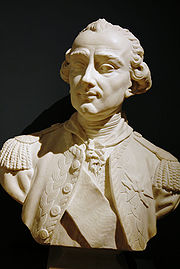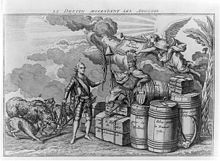- Charles Hector, comte d'Estaing
-
Charles Hector, comte d'Estaing 
Bust by Jean-Pierre-Victor Huguenin, on display at the Musée national de la MarineBorn 24 November 1729 Died 28 April 1794 Allegiance Ancien Regime France
French First RepublicService/branch Army, Navy Rank Lieutenant General, Admiral Battles/wars War of the Austrian Succession
Seven Years War
American War of IndependenceJean Baptiste Charles Henri Hector, comte d'Estaing (24 November 1729 – 28 April 1794) was a French general, and admiral. He began his service as a soldier in the Seven Years War, spending time as a prisoner of war of the British. Following France's entry into the American War of Independence in 1778, he led a fleet to aid the American rebels, but participated in failed Franco-American attacks on Rhode Island and the Siege of Savannah. He returned to France in 1780.
He was subsequently executed in the Reign of Terror during the French Revolution.
Contents
Biography
He was born at the Château de Ravel in Auvergne to Charles-François, the Marquis de Saillant and a lieutenant general, and Marie-Henriette Colbert de Maulevrier, a descendant of Jean-Baptiste Colbert. He entered the army as a colonel of infantry, serving in Flanders during the War of the Austrian Succession. In 1757, he accompanied count de Lally to the East Indies, with the rank of brigadier-general. In 1759, he was taken prisoner at the siege of Madras, but was released on parole. Before the ratification of his exchange, he entered the service of the French East Indian Company and, with two vessels, destroyed the British factories in Sumatra and the Persian Gulf.
On his way back to France in 1760, he fell, accidentally, into the hands of the British. On the ground of having broken his parole, he was thrown into prison at Portsmouth but as the charge could not be substantiated, he was soon afterwards released. In 1763, he was named lieutenant-general in the French Navy,rising by 1777 to the rank of vice-admiral.
American War of Independence
Main article: Franco-American allianceAt the entry of France into the American War of Independence in 1778, he left Toulon in command of a fleet of twelve ships of the line and fourteen frigates with the intention of assisting the American colonies against Great Britain. He sailed on 13 April, and, between the 11th and the 22nd of July, blockaded the smaller British fleet of Lord Howe at Sandy Hook, the entrance to New York harbour. D'Estaing did not enter the harbour because his largest ships were believe to be unable to clear the bay's bar.
Newport
Main article: Battle of Rhode IslandIn cooperation with the American generals, he planned an attack on Newport, Rhode Island, preparatory to which he compelled the British to destroy some war vessels that were in the harbor. Before the concerted attack could take place, he put to sea against the British fleet, under Admiral Howe. Owing to a violent storm, which arose suddenly and compelled the two fleets to separate before engaging in battle, many of his vessels were so shattered that he found it necessary to put into Boston for repairs. While being in Newport he was assisted by captain Caleb Gardner against the British forces. He then sailed for the West Indies on 4 November. After a failed attempt to retake St Lucia from Admiral Barrington, he captured St Vincent and Grenada.
On 6 July 1779, he fought the Battle of Grenada[1] against Admiral Byron, who retired to St. Kitts. Though superior in force, d'Estaing would not attack the British in the roadstead but set sail to attack Savannah.
Siege of Savannah
Main article: Siege of SavannahThe siege consisted of a joint Franco-American attempt to retake Savannah from 16 September 1779 to 18 October 1779. On 9 October 1779, a major assault against the British siege works failed. During the attack, Polish Count Kazimierz Pułaski, fighting on the American side, was mortally wounded. With the failure of the joint American-French attack, the siege failed, and the British remained in control of coastal Georgia until they evacuated it in July 1782, close to the end of the war.
Return to France
He returned to France in 1780 on crutches, but he fell into disfavour at the court, and was strongly criticised by his subordinates. Friends of Benjamin Franklin jokingly suggested that the French Court at Versailles should provide America with the names of other gifted admirals.[2] In 1781 the French sent a fleet under de Grasse, along with an expeditionary force, which enjoyed more success and was credited with contributing to the surrender of the British army at Yorktown in 1781. Three years later, however, d'Estaing was placed at the head of the Franco-Spanish fleet assembled before Cádiz, but the peace was signed and no operations took place.
From that time, his chief attention was devoted to politics. He was first made a grandee of Spain and, in 1787, he was elected to the Assembly of Notables. When the French Revolution broke out, he favoured the new ideas. In 1789, he was appointed to the National Guard at Versailles and, in 1792, he was chosen admiral by the National Assembly. Though in favour of national reform, he remained loyal to the royal family, and, in the trial of Marie Antoinette in 1793, bore testimony in her favour. On this account, and because of certain friendly letters which had passed between him and the queen, he was himself brought to trial, charged with being a reactionary. He was sent to the guillotine on 28 April 1794. Before his execution, he wrote "After my head falls off, send it to the British, they will pay a good deal for it!" [3]
In his moments of leisure, he wrote a poem, Le Rêve (1755), a tragedy Les Thermopyles (1789) and a book on the colonies.
Citations and notes
References
- Schiff, Stacy. Benjamin Franklin and the Birth of America. Bloomsbury, 2006.
- Stephens, Alexander, Public Characters of 1807, volume IX, R. Phillips, by T. Gillet, 1807
 This article incorporates text from a publication now in the public domain: Chisholm, Hugh, ed (1911). Encyclopædia Britannica (11th ed.). Cambridge University Press.
This article incorporates text from a publication now in the public domain: Chisholm, Hugh, ed (1911). Encyclopædia Britannica (11th ed.). Cambridge University Press.- Chateau de Revel, Road of the castles of Auvergne
Categories:- 1729 births
- 1794 deaths
- People from Puy-de-Dôme
- French Navy admirals
- French military personnel of the American Revolutionary War
- French military personnel of the War of the Austrian Succession
- French military personnel of the Seven Years' War
- Counts of Estaing
- People executed by guillotine during the French Revolution
- Executed French people
- Members of the Society of the Cincinnati
Wikimedia Foundation. 2010.


